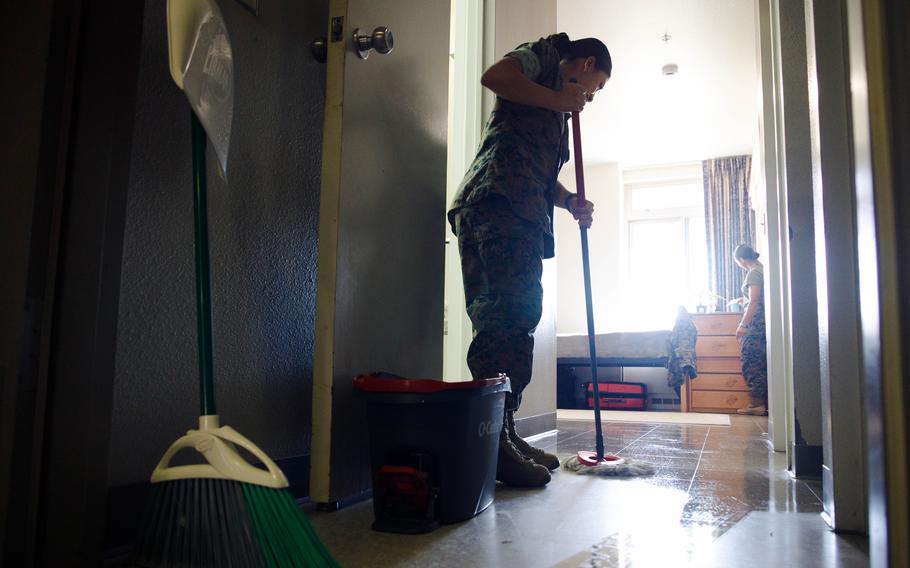
Marine Corps Pfc. Emily Laragonzalez and Pfc. Nayeli Dominguez clean their room at Marine Corps Base Camp Pendleton, Calif., on April 10, 2025. (Luke Rodriguez/U.S. Marine Corps)
WASHINGTON — The Marine Corps’ barracks improvement effort is being hindered by uncertain congressional funding and the federal hiring freeze as the service has pushed back its completion goal to at least 2037.
“[Our Marines] don’t ask for much — just a decent, quiet place to lay their head at night. With a continuing resolution, all that comes to a screeching halt,” Gen. Eric Smith, commandant of the Marine Corps, said Thursday at the Modern Day Marine expo in Washington.
With a price tag of about $11 billion, the Marine Corps Barracks 2030 initiative aims to modernize unaccompanied housing for single Marines, streamline barracks maintenance and refresh furniture and appliances every 10 years. The initiative, with an initial target completion of 2030, is now on track to have Marines in modernized barracks by 2037, service officials said this week.
But delays in funding, such as the stopgap measure under which the federal government is operating, could push the completion date to as late as 2045. Additionally, President Donald Trump implemented a federal hiring freeze in January that is preventing the Marine Corps Installations Command from hiring about 150 civilian housing specialists to do work now being done by Marines. Those specialists were slated to start in February but are unable to do so until the hiring freeze is lifted.
The federal government has been operating under a full-year continuing resolution since March 14, after lawmakers failed to agree on appropriations for fiscal 2025, which began Oct. 1. The stopgap funding bill is a temporary extension of last year’s funding, plus an additional $6 billion for pay raises for junior troops as well as weapons purchases and operations.
“You can’t hire the labor. You can’t buy the building or materials. You can’t start a new project. So, you continue to put lipstick on a pig, and you keep the old barracks around for just another year, and another year, and another year,” Smith said.
About 17,000 junior enlisted Marines were living in squalid barracks as of 2023, according to the Government Accountability Office, a federal watchdog report. During barracks inspections at various installations, the GAO observed mold, pests, sewage issues, and extreme temperatures.
With questions about long-term funding, the Marine Corps is doing what it can now to improve the barracks, service officials said. Eric Mason, unaccompanied housing team lead for the Marine Corps Installations Command, said Wednesday that the number of Marines living in poor conditions was lower than 17,000 now.
“I can only tell you that number has decreased, and it will continue to decrease. Once we get out to our potential 2030 — or 2035, 2037 — [completion date], that number should hopefully go away,” Mason said.
The service has 11 ongoing renovation projects, with 12 more in the pipeline. Additionally, programs are being rolled out at Marine Corps bases that are collecting data on streamlining maintenance and improving barracks security.
The service launched a pilot program in March at Marine Corps Air Station Beaufort, S.C., that installed common access card-enabled door locks on nine barracks. A common access card is the standard identification for active-duty troops.
The program at Beaufort is meant to provide better security for troops, as they swipe into their private rooms rather than using a key or a key card. Troops also must swipe into common areas in the barracks buildings.
The program will run for one year before it potentially expands to other installations. If approved by the Defense Department, Mason said CAC-enabled locks would likely not become standard for Marine barracks until at least 2027.
The Marine Corps also rolled out a program for troops living in barracks to submit maintenance requests to building managers to streamline repairs for issues such as leaks, mold and pests. The online portal is already seeing widespread use, capturing 1,000 requests per week.
“As someone from public works, that’s a bit of a concern. We want to get that number down. We don’t want the main source of things that need to be fixed in the building to be the Marines seeing the problem,” said Jason Canfield, program manager for QSRMax, the new service portal that Marines use to register maintenance requests.
While the service initially aimed to make certain current junior enlisted Marines would see improved barracks conditions, the new timeline for 2037 or later means they might not benefit from the Barracks 2030 initiative. But service officials said fixing the barracks remains a top priority.
“When you start hearing Marines say, ‘I am going to my home’ [when] referring to barracks — I think that’s a great way to measure the success that we have had on improving the quality of life,” Mason said.